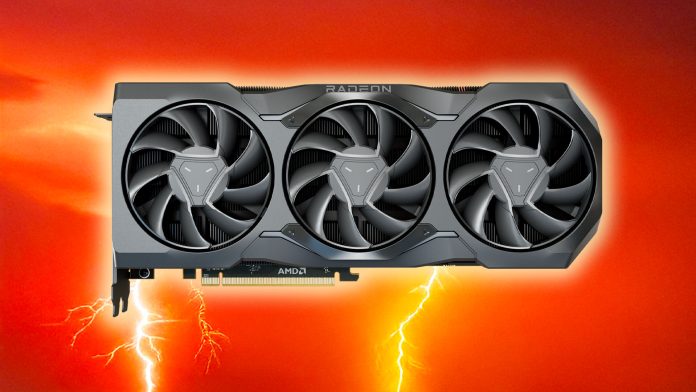As an Amazon Associate, we earn from qualifying purchases and other affiliate schemes. Learn more.

A fresh new stack of leaks has just dropped about the next generation of AMD Radeon GPUs, and they point to an extremely powerful graphics card at the top end that’s at least 50% more powerful than the Radeon RX 9070 XT and could take on the future RTX 6080 from Nvidia. At the moment, AMD has no product to compete with Nvidia when it comes to high-end GPUs, but it looks as though the company is planning an all-out assault with its next generation of RDNA 5 graphics cards.
This isn’t the first time we’ve seen rumors about a new high-end AMD GPU, with a previous leak pointing to the Radeon RX 10090 XT (or whatever it ends up being called) potentially being able to take on the RTX 5090. This latest rumor tones down the adrenaline a bit, but there’s a good chance this new GPU could unseat the RTX 5080 in our guide to buying the best graphics card if this rumor is true.
This latest leak comes from Kepler_L2 on the Anandtech forums, who has form for AMD GPU leaks, having correctly leaked the number of compute units, the amount of memory, and the amount of Infinity Cache of the top-end RDNA 4 GPU, which we now know as the 9070 XT, back in December 2024. This time, Kepler_L2 has shared some block diagrams that show four new AMD GPUs, with the top-end model having some seriously powerful specs.
I’ve shared this diagram below, and it shows a GPU that’s packed with 96 compute units (CUs), which are the basic building blocks of AMD GPUs, containing the stream processors, RT cores for ray tracing, and AI cores. As a point of comparison, the Radeon RX 9070 XT only has 64 compute units, and still gives the RTX 5070 Ti a run for its money, so this GPU looks set to be at least 50% more powerful, and probably more, because there’s rumored to be a 10% increase in rendering performance between like-for-like RDNA 4 and RDNA 5 GPUs.

Each set of six compute units has a render backend (RB), while the graphics command processor (GCP), hardware scheduler (HWS), and L2 cache sit in the middle. The whole lot is also surrounded by a total of 16 unified memory controllers (UMCs), and if these are each 32-bit, then we could be looking at a super-wide 512-bit memory interface in total, as used on the RTX 5090 today. That easily gives AMD the scope to equip this graphics card with 32GB of memory (or even 48GB using 3GB chips), with very high bandwidth, depending on the speed and type of memory used.
According to the earlier leak linked above, AMD is splitting its RDNA 5 lineup into several tiers, all of which start with AT, which stands for Alpha Trion. This chip looks like it could be the AT0 model that sits at the top, while the other block diagrams leaked by Kepler_L2 could refer to the cheaper AT2, AT3, and AT4 models.
Assuming that’s the case, AT2 would correspond with the next block diagram down, which instead organizes compute units into blocks of five per render backend, rather than six. This diagram shows a total of 40 compute units, along with six memory controllers, implying a 192-bit bus. This spec would put it in between the Radeon RX 9060 XT (32 CUs) and Radeon RX 9070 (56 CUs), suggesting that AMD is looking to provide a GPU between the traditional budget and mid-range options with this generation.

Below this is a diagram of a GPU that only has 24 compute units, which could be AT3, a GPU that’s also mentioned in the latest video from Moore’s Law is Dead, which you can see below. MLID states that this GPU has 48 compute units, which is exactly double the number, suggesting some confusion about the number, perhaps because they’re dual-issue units – both RDNA 3 and RDNA 4 compute units have the ability to execute two instructions per clock cycle, as they effectively contain two engines.

This diagram shows eight memory controllers, though, which is more than the one before it, potentially giving it a 256-bit memory bus, meaning it could be paired with slower memory and still achieve decent bandwidth. MLID has speculated that this GPU could even be paired with cheap LPDDR5X memory to bring down the cost, with its bandwidth boosted by the wide bus.
Finally, at the end is what looks like a very simple, super-cheap GPU with just 12 compute units and four memory controllers, which would still give it a 128-bit bus. Again, though, this is half the number of compute units suggested by MLID.
Of course, as with all stories based on rumors and leaks, take this all with a grain of salt for now, but I’d love to see AMD come back fighting with a true high-end GPU, as strong competition ultimately brings down prices. With 96 RDNA 5 compute units, AMD probably wouldn’t be able to take on the RTX 6090, but it would potentially have a good shot at dethroning the RTX 6080, depending on what Nvidia brings us with its own next-gen GPUs.
In the meantime, one area where AMD is leading the pack is CPUs, and if you’re thinking of upgrading, you can check out our guide to buying the best gaming CPU, as well as the best CPU cooler to keep its temperatures in check.
Would you like to see AMD make a genuine comeback in the high-end GPU market? Discuss the latest GPU tech with us on our community Discord channel.
